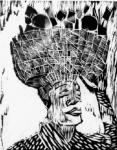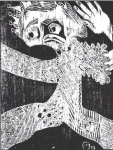Adulthood in Brazil & Germany
My first encounter with the Hebrew scripture though, took place when I was already thirteen years old. We had all gathered in our synagogue to celebrate one of the Jewish Holidays and while my girlfriends were excitedly showing off the new dresses they were wearing, I intently stared at the prayer book that had been just handed to me. I was deeply touched by the sight of the Hebrew letters and the Portuguese transliteration of the prayers; all of a sudden an overwhelming sense of belonging to the Jewish People, a totally unknown feeling took hold of me. There and then I made up my mind to learn more about the ancient language and scripture our prayers were written in. What an enormous impact though, this spontaneous decision would have on my future life, I could not foresee then.I was delighted to discover a small synagogue with a beautiful Torah shrine in Petropolis, where Polish Jewish immigrants would meet and pray, and when our relatives from Sao Paulo visited with us for the holidays, I would get them to take me there. Only occasionally would my mother come along with us, but I was happy to meet with the Weil family from Stuttgart regularly, instead.
 Church In Brazil Church In Brazil
|
In the little synagogue of Petropolis I also heard for the first time the blowing of the Shofar (ram's horn), at Rosh Ha-Shana. Since in Hebrew one of the blowings is called Tekia, I named the old gentleman who blew the horn "Mr. Tekia".
My father would neither go to synagogue - if he could avoid it – and nor would he engage in talks about Judaism, only my mother would sometimes agree to tell me a little about our religion and tradition.
As I mentioned before, my aunt Ellen was the only one in our family to introduce me to Judaism, its prayers, and customs.
I could feel her love for the Jewish tradition and that I could talk to her openly about it; she would answer all my questions as best as she could and willingly share her knowledge with me.
Yet during the four coming years and until my graduation from high school, I would visit an expensive catholic nun school which my parents, who wanted me to have the best education attainable in Petropolis, had chosen for me. I was a diligent student and the very tight schedule at school left me with little time to do anything else, so even though by the time I had finished high school I was quite familiar with some of the Jewish prayers, customs and holidays, my knowledge of Torah and Shabbat Laws, the pillars of Judaism, was not really worth mentioning.
Still, despite it being an all-day school, the four years I spent at Notre Dame de Sion were happy years for me. I loved to learn and the nuns were kind and gentle teachers. Like them, I would sometimes take walks in the lovely inner courtyard to learn or just to take a break between classes. We all wore a school uniform and all my non-Jewish class mates wore also the chain and cross they had been given by the nuns. I wouldn't wear the cross and came to school with only the empty chain showing on top of my uniform but to my amazement the kind nuns presented me with a golden David Star. I neither participated in religion class nor did I go to chapel with my class mates and the nuns obviously did not expect me to. To our graduation ceremony the Bishop of Petropolis had been invited and my class mates and I, twelve young women wearing purple uniforms, the graduation year color, were supposed to kneel before the Bishop and kiss his ring. Even though I had been the best student in my class I was exempted of this obligation. Maybe their remarkable attitude of respect and tolerance towards me, the only Jewish student in school, had something to do with the fact that the founders of the Notre Dame de Sion congregation had been converted French Jews who devoted their lives to the conversion of their fellow Jews to Christianity.
Sour Angela, our class tutor, would taught Ethics and I remember how taken I was by issues such as self-discipline and moral behavior. Though I lived in the safe world that my parents had created for my brother and me, I had already become aware of the fact that not everybody around me was as privileged as I was and I made my mind up there and then, that I would fight injustice wherever I could. As I listened to Sour Angela I realized how much I did not know and how much I would have to learn and understand yet, in order to be able to fight for justice and equality for all, they way I wished to.
Unfortunately my parents would not share my views, they either could not understand me or they regarded my "revolutionary" ideas as an adolescent outburst soon to pass and best to be ignored.
I therefore decided to educate and train myself to self-discipline; I wanted to become a just, honest and responsible human being as I had read in my Jewish Prayer books, that G-D wanted and expected me to be, and help people in distress.
My long way to school along the State Museum and the old Emperor's Palace lead me down a white paved road that was marked in the middle with a straight black line. Without any deviation, like this black line I told myself, my own life should be.
 Brazilian Brazilian
|
When my parents had to flee Nazi-Germany they found in Brazil a friendly and tolerant country that welcomed them with open arms and they were forever grateful, but as far as I was concerned the fact that I had been born there, wasn't enough reason to make me feel at home.
The vague idea that some day I would love to go live in Israel, that there I could help other people and also maybe realize my dreams of working for a just and better world, started to form in my mind.
I was only eighteen years old then and before I could embark on new and far ventures I had first to learn a profession that would enable me to make a living for myself. I passed the admission exams at the "Universidade Nacional" in Rio, began my first term of social sciences and enrolled at "Instituto de Bellas Artes" to study art where I greatly enjoyed studying as well as the company of my new fellow students. My parents who obviously disliked to see their only daughter become more and more involved with the teachings of Socialism and Communism at the university, sent me 1963 from the beautiful Sugar Loaf below which the university was located, for a one year term to far away Munich in Germany, to study graphic arts.
Since they were convinced that my chances of becoming a graphic artist were greater than those of becoming a famous pianist, they also sold my piano that I loved so much and used the money they pay for my flight ticket.
Even though I was hurt and disappointed, I agreed to leave since this gave me a unique chance to get away from home and Brazil. I figured that Israel wasn't as far from Europe as it was from Brazil and thus much easier for me to reach from there.
 Taking Leave Taking Leave
|
In Munich I lived in a rather inexpensive girls' residence that allowed me to spend all my spare money for traveling and visiting the art museums of most of Europe's capitals during my vacations from school. I was delighted to see so many of the beautiful paintings and sculptures I had admired and read about; while there I wanted to learn about art and its history as much as possible.
